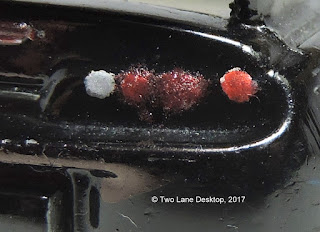Matchbox 1995 Toyota Supra
The fourth-generation Supra is one of the most well-known Japanese sports
cars to car enthusiasts thanks to a starring role in the first “The Fast and
the Furious” movie in 2001 and since then has created all sorts of replica’s
based on the movie car. That is also the
downside as it is hard to find a nice, clean, stock version of the Supra until
you realize that Matchbox had one years before the Fast and Furious hype.
The fourth-generation Supra was a radical move from past Supra’s; in the
first two generations the Supra was nothing more than a Celica with a longer
nose to accomidate the I-6 motor under the hood, then by the third-generation
the Supra started to become its own model as the Celica went to front-wheel
drive. The fourth-generation also shares
its platform with the new Lexus SC400 coupe and has similar rounded styling,
though the Supra has a sportier look with multi-projector lamps front and rear
and a tall rear wing spoiler not seen since the Plymouth Superbird of 1970. The interior has a driver-oriented layout
with the controls on the dashboard curved toward the driver and the option of a
removable targa top on some models.
Engines also came in two, whether the naturally aspirated 3.0L DOHC I-6
or the twin-turbo I-6 that uses sequential turbo’s to combat turbo lag (one for
low-speed spool and the other for high-speed spool) to produce 320 horsepower
and was offered with a six-speed manual over the 5-speed of the non-turbo
models. Rising Yen and low demand for
sports cars led to the end of the Supra in the U.S. for 1998, Canada for 1996,
and for the rest of the world in 2002.
Matchbox was first to replicate the Supra casting, which is surprising give
the Tyco-era Matchbox that was focused on cars with vivid colors, wild graphics,
and animal-shaped vehicles. The Supra
has a metal base with detailed engine, drivetrain, and exhaust systems and
earlier versions had a hole in the center of each axle for no apparent reason. The car started life with wild graphics
unless you opted for the Premiere series like the gold one shown here and this
is where you get realistic details; by 1998 Mattel owned Matchbox and thus
cleaner models started to appear with the new 5-spoke wheels and the clean look
is shown in this black version with gold Supra across the doors. The front has a stock look with detailed
tri-headlight projectors on the Premiere model and lower grille with signal
lights in the side grilles. The sides
have a clean, sweeping profile with side scoops just ahead of the rear wheels
to cool the rear brakes and the sweeping fastback roofline that ends in the
metal rear spoiler. The rear has
detailed quad taillights and Supra on the metal base tab license plate area on
the Premiere model; the one downside of these Premiere models is the wheels
that are too wide and stick out past the fenders and also rub up against the
fenders hindering the working suspension on most models. The Supra does not have a working
suspension. Inside the interior has
seating for four, a smooth dashboard layout with no controls, 3-spoke steering
wheel and on the Premiere model a nice red and black two-tone look. Since then more Supra castings have appeared,
yet again most of them go for the tuner look so this Matchbox version is the
only stock example of the Supra in 1:64, though it would’ve had a better time
if it was released during the Mattel-era’s clean, minimal tampo era.



























Comments
Post a Comment